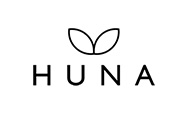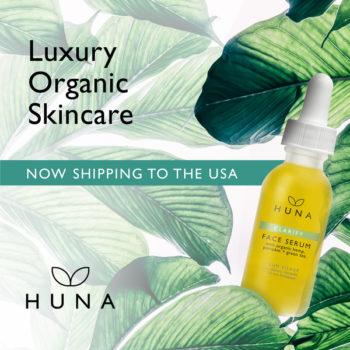Your cart is currently empty!
THE HUNA BLOG
The Gut-Skin Connection Series 3: Achieve + Maintain Optimal Gut Health for Optimal Skin Health

Welcome back glow getter! We’ve talked about the connection between our Gut microbiome and our Skin, and we’ve addressed the bacteria imbalance associated with inflammatory skin disorders. Today it’s time to chat about what we can do with this information! With each skin disorder, a common thread appears – an unbalanced gut microbiome. A healthy gut means healthy skin, even if you’re not taming an inflammatory skin disorder, a balanced microbiome is one step closer to that dewy healthy glow.
Our gut microbiome is made up of trillions of bacteria. In a perfect world, we would have 85% good bacteria, with 15% bad bacteria. When this ratio changes, we will start to see symptoms arise. Small intestinal bacterial overgrowth (SIBO) can compromise proper absorption of proteins, fats, carbohydrates, B vitamins, and other micronutrients due to bacterial interference.
With this information, we know we want to keep our good bacteria, and gut flora happy. Thankfully, we can accomplish this through eating a diverse diet – not diverse in the sense of mixing healthy, and non-healthy foods – diverse in the way of many types of healthy probiotic, prebiotic, and plant-based foods.

Probiotics
Probiotics, or as some manufacturers refer to as “live or active cultures”, are present in the foods we eat as well as in supplement form. These beneficial bacteria join the bacteria that already exist in our stomachs and add diversity. Food processing procedures often kill off these bacteria- if the product is available on the shelf, not refrigerated- it may not contain vital living actives. Some of the best probiotic foods and drinks are yogurt (go for dairy-free), kimchi, kefir, kombucha, sauerkraut, miso, sourdough bread (aim for gluten-free), pickles & picked vegetables, and other fermented products. Try to work these into your diet a few times a week! You may not recognize some of the foods on our list. Some tips when shopping for your probiotic foods:
- Yogurt – Be careful to not buy just any kind of yogurt. Some yogurts do not contain live probiotics as they are killed off during processing- these types may contain high amounts of sugar. Instead, look for yogurt that states it contains live or active cultures. We recommend coconut-based yogurt (or any dairy-free alternative yogurt), since dairy is difficult to digest and can trigger inflammatory reactions in so many people.
- Kimchi – A Korean dish made from salted, fermented veggies with a wide selection of seasonings including chili powder, green onions, garlic, ginger, etc.
- Fermented Pickled Vegetables – Fermented cucumbers (pickles) and pickled vegetables made in salt water brine do contain healthy probiotics, however pickles made in vinegar typically do not contain live probiotic cultures. Make your own homemade pickled vegetables using salt water rather than reaching for the processed supermarket sort. Here’s a great recipe to try making your own fermented and probiotic-rich pickles.
- Kefir – A fermented, probiotic, yogurt/milk-like drink. It is made by adding kefir grains to cow, goat, sheep’s milk, or coconut milk.
- Kombucha – A tasty fermented black or green tea-based beverage. Widely available at most grocery stores. Be sure to check the label to ensure the one you choose is not too high in sugar.
- Sauerkraut – Sauerkraut is finely cut raw cabbage that has been fermented by various lactic acid bacteria. Aside from its good bacteria, it also contains high levels of fiber, and vitamins B, C, and K.
- Miso – Traditional Japanese seasoning produced by fermenting soybeans with salt and koji. The result is a thick paste used for sauces and spreads, pickling vegetables or meats, and mixing with dashi soup stock to serve as miso soup.

Prebiotics
Prebiotics are types of dietary fiber that feed the friendly bacteria in your gut and prevent the bad bugs from multiplying. The good bacteria use prebiotics to aid in the digestion process and supporting your colon cells. Foods that contain prebiotics include: Garlic, onions, leeks, Jerusalem artichoke, dandelion greens, chicory root, asparagus, bananas, barley, oats, apples, and the list goes on. Most of these foods are fairly easy to recognize and are available at your local grocery store. When choosing your prebiotic foods- always try to buy organic and local (where possible).
The “Other Stuff”
Once you’ve got your pre and pro-biotic foods working, you want to round out your intake with fresh, local fruits and vegetables, finishing with lean proteins. Polyphenols are also very helpful, being micronutrients that we get from plant-based foods. They are jammed with antioxidants and significant potential health benefits. Polyphenol-rich foods such as cocoa, green tea and olive oil, can also increase healthy gut bacteria levels.
Avoid foods rich in refined carbohydrates and sugars, “the white foods”- a few being white bread, white sugar, white rice, artificial sweeteners, sweets, potato chips, and other heavily processed foods. Also consider staying away from milk, and other dairy products as these may cause inflammation in your body and irritation to your skin. Whenever your skin is looking less-than-lovely, look at your diet and make adjustments.
A great rule of thumb for grocery shopping is to stay along the perimeter of the store, where the fresh, nutritious foods are located.
Drink Up, Buttercup!
As always, make sure to drink plenty of water. This helps us flush the body to achieve happier and healthier skin in a number of ways including hydration and improving gut mucosal lining…enter dewy glow and healthy gut! If you aren’t in love with the idea of drinking water throughout the day, try flavouring it naturally with fruit, veggie and herb infusions. Some of our favourite blends are cucumber + mint, strawberries + basil, watermelon + mint, citrus + ginger, or thyme + blackberries. We recommend starting your morning with a cup of warm or hot water and lemon or lime (about ½ lemon or lime should do it!), as it helps to keep your stomach acid at a healthy level and aid in digestion. Many people who have more irritable stomachs or just trouble digesting food will start each meal with lemon water to prepare their stomach acid for digestion. It’s very effective, simple to incorporate into your daily routine, and your skin will be glowing within days.
We know it’s a lot, but incorporating even just a few of these healthy habits into your routine will have you well on your way to a happy, healthy gut and glowing healthy skin!
Written by Brittany Hay and Kelsie Oliphant of Team Huna. Brittany is Huna’s Holistic Beauty Expert + Retail Support Specialist. She is a trained professional Aesthetitian, passionate about clean beauty, and has studied Holistic Nutrition. Kelsie is Huna’s Production + Operations Assistant. She has a Bachelor of Science degree in Neuroscience from Dalhousie University and is passionate about sustainability and all things green n’ clean.



